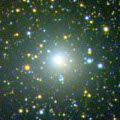
|
Now it is so bright as 8.9 mag (Sept. 17, Marco Goiato). It will be observable at 8-10 mag in good condition for a long time until late autumn.
Date(TT) R.A. (2000) Decl. Delta r Elong. m1 Best Time(A, h)
Sept.19 19 25.51 5 17.3 2.656 3.208 114 8.5 19:31 ( 0, 60)
Sept.26 19 19.57 2 20.3 2.781 3.224 107 8.6 19:15 ( 8, 57)
|
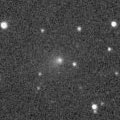
|
Now it is so bright as 9.2 mag (Sept. 17, Marco Goiato). It keeps observable for a long time until 2010 February. It will keep 9 mag until the end of 2009. But in the Northern Hemisphere, it keeps very low after this. It locates a bit higher in the Southern Hemisphere.
Date(TT) R.A. (2000) Decl. Delta r Elong. m1 Best Time(A, h)
Sept.19 15 31.88 -21 31.2 1.587 1.388 59 9.1 19:26 ( 52, 12)
Sept.26 15 55.07 -22 58.7 1.600 1.376 58 9.0 19:15 ( 50, 12)
|
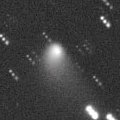
|
It brightened up to 9.8 mag on June 13 (Marco Goiato). Now it is not observable. But it keeps as bright as 10-11 mag for a long time untio 2010 spring. In the Northern Hemisphere, it will appear in the morning sky in early October, then it keeps observable at 10 mag in good condition for a long time. In the Southern Hemisphere, it will locate extremely low only after this.
Date(TT) R.A. (2000) Decl. Delta r Elong. m1 Best Time(A, h)
Sept.19 10 25.82 6 2.6 3.176 2.261 20 9.6 4:20 (263, 1)
Sept.26 10 39.18 6 42.3 3.133 2.255 24 9.5 4:26 (265, 5)
|
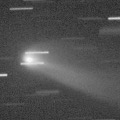
|
Now it is so bright as 9.9 mag (Aug. 31, Juan Jose Gonzalez). It will be observable at 10-11 mag in a good condition for a long time from summer to winter.
Date(TT) R.A. (2000) Decl. Delta r Elong. m1 Best Time(A, h)
Sept.19 5 14.24 -4 6.8 0.586 1.231 97 10.7 4:20 (336, 48)
Sept.26 5 33.48 -4 22.2 0.593 1.243 99 10.6 4:26 (342, 49)
|
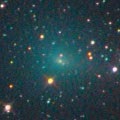
|
It brightened up to 8.8 mag in May and June (May 19, Juan Jose Gonzalez). Now it is still bright as 10.5 mag (Sept. 14, Marco Goiato). It will be bright at 9-10 mag for a long time until autumn.
Date(TT) R.A. (2000) Decl. Delta r Elong. m1 Best Time(A, h)
Sept.19 22 38.38 -15 47.4 0.975 1.943 158 11.3 22:44 ( 0, 39)
Sept.26 22 36.83 -15 55.6 1.043 1.981 151 11.6 22:15 ( 0, 39)
|
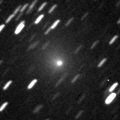
|
It brightened up to 8.5 mag in May and June (May 26, Juan Jose Gonzalez). Now it is fading, but still bright as 10.8 mag (Sept. 12, Marco Goiato). It will never be observable again in the Northern Hemisphere. In the Southern Hemisphere, it keeps observable for a long time after this in the evening sky.
Date(TT) R.A. (2000) Decl. Delta r Elong. m1 Best Time(A, h)
Sept.19 13 4.09 -51 48.2 2.262 1.892 55 11.4 19:26 ( 45,-29)
Sept.26 13 37.15 -53 21.5 2.359 1.967 55 11.7 19:15 ( 42,-27)
|
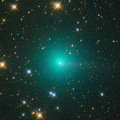
|
It brightened up to 6.7 mag in June (June 9, Marco Goiato). It faded down to 9.5 mag on Aug. 21 (Juan Jose Gonzalez), then it became unobservable. Now it is not observable. But it will appear in the morning sky again at 13 mag in November. It may be visible visually again.
Date(TT) R.A. (2000) Decl. Delta r Elong. m1 Best Time(A, h)
Sept.19 12 59.23 5 53.0 3.039 2.114 18 11.4 19:26 ( 98, -1)
Sept.26 13 3.36 6 39.8 3.111 2.160 15 11.7 19:15 (100, -3)
|

|
It must have reached up to 11 mag in summer. However, the condition of this apparition is worst. We can not observe it at all.
Date(TT) R.A. (2000) Decl. Delta r Elong. m1 Best Time(A, h)
Sept.19 11 52.84 8 1.3 2.314 1.322 6 13.3 19:26 (109,-13)
Sept.26 12 15.39 5 34.8 2.349 1.359 6 13.9 19:15 (106,-13)
|

|
It brightened up to 11 mag in spring and summer. Now it is not observable. It will appear in the morning sky at 15 mag in early 2010. But it locates somewhat low in the Northern Hemisphere.
Date(TT) R.A. (2000) Decl. Delta r Elong. m1 Best Time(A, h)
Sept.19 13 28.89 -10 4.4 3.053 2.219 28 13.4 19:26 ( 80, -4)
Sept.26 13 43.00 -11 31.8 3.096 2.229 25 13.5 19:15 ( 79, -5)
|
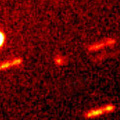
|
Now it is 14.8 mag (Sept. 6, Hidetaka Sato). It will be getting higher after this. It will be observable bright as 9-10 mag in a good condition for a long time from winter to spring. It keeps observable until 2010 autumn when it fades down to 16 mag.
Date(TT) R.A. (2000) Decl. Delta r Elong. m1 Best Time(A, h)
Sept.19 8 21.97 17 54.1 2.632 2.173 52 14.1 4:20 (270, 32)
Sept.26 8 36.93 17 4.7 2.530 2.133 55 13.8 4:26 (274, 36)
|
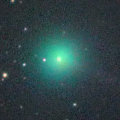
|
It has been observed bright as 8-9 mag from April to June. Now it is fading. It was still bright as 11.0 mag in July (July 12, Marco Goiato). However, no observations have been reported since August. So it may have faded out rapidly. In the Southern Hemisphere, it keeps observable in a good condition for a long time. In the Northern Hemisphere, it will never be observable again.
Date(TT) R.A. (2000) Decl. Delta r Elong. m1 Best Time(A, h)
Sept.19 10 30.95 -51 7.4 2.968 2.529 55 13.9 4:20 (314,-29)
Sept.26 10 37.37 -51 37.8 3.066 2.609 54 14.1 4:26 (317,-26)
|

|
Appearing in the morning sky, and already bright in outburst. Now it looks stellar as 11.5 mag (Sept. 16, Juro Kobayashi).
Date(TT) R.A. (2000) Decl. Delta r Elong. m1 Best Time(A, h)
Sept.19 9 24.30 15 11.1 6.929 6.161 37 14.1 4:20 (264, 18)
Sept.26 9 28.69 14 46.0 6.857 6.163 43 14.1 4:26 (268, 24)
|
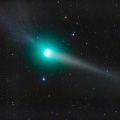
|
It passed near by the earth in late February, and it reached up to 4.9 mag (Feb. 23, Juan Jose Gonzalez). It had been unobservable for a while, but it is appearing in the morning sky again. it is still bright as 13.7 mag and visible visually (Aug. 28, Jakub Cerny). In the Northern Hemisphere, it is observable at 15 mag in good condition from autumn to winter.
Date(TT) R.A. (2000) Decl. Delta r Elong. m1 Best Time(A, h)
Sept.19 7 18.19 20 49.8 3.816 3.561 67 14.5 4:20 (276, 47)
Sept.26 7 16.01 20 50.3 3.758 3.634 75 14.5 4:26 (283, 54)
|

|
Now it is not observable. It will appear in the morning sky again in 2010 February. It will brighten up to 12-13 mag in 2010 summer. But it locates somewhat low in the Northern Hemisphere.
Date(TT) R.A. (2000) Decl. Delta r Elong. m1 Best Time(A, h)
Sept.19 13 48.25 -6 58.2 3.437 2.637 31 14.5 19:26 ( 80, 2)
Sept.26 13 59.31 -8 16.9 3.465 2.622 27 14.5 19:15 ( 80, 0)
|
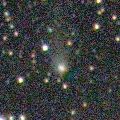
|
It brightened up to 11.5 mag in last summer (Aug. 4, Marco Goiato). Now it is 15.9 mag (Aug. 12, Hidetaka Sato). It keeps observable in good condition for a long time in the Southern Hemisphere. It will be observable again also in the Northern Hemisphere after September. It will keep 15-16 mag until next spring.
Date(TT) R.A. (2000) Decl. Delta r Elong. m1 Best Time(A, h)
Sept.19 6 39.80 -39 22.6 4.118 4.076 80 14.7 4:20 (332, 8)
Sept.26 6 38.95 -39 57.9 4.111 4.126 83 14.7 4:26 (338, 11)
|

|
It brightened up to 9.8 mag in winter (Dec. 28, Juan Jose Gonzalez). It faded down to 12.5 mag in May (May 26, Juan Jose Gonzalez), and became unobservable. It is appearing in the morning sky again. It will be observable in good condition again in winter at 15 mag. Then it may be still visible visually.
Date(TT) R.A. (2000) Decl. Delta r Elong. m1 Best Time(A, h)
Sept.19 9 51.55 12 34.2 5.335 4.496 30 14.8 4:20 (262, 11)
Sept.26 9 57.03 11 44.5 5.328 4.551 35 14.8 4:26 (267, 16)
|

|
Now it is 15.2 mag (Aug. 3, Hidetaka Sato). It passes the perihelion in September, and now it is brightest. It keeps observable in good condition in the Southern Hemisphere. It is not observable now in the Northern Hemisphere. But it will appear in the evening sky at the end of September, and then it will be getting higher while fading.
Date(TT) R.A. (2000) Decl. Delta r Elong. m1 Best Time(A, h)
Sept.19 17 16.56 -50 6.3 0.749 1.217 86 14.8 19:26 ( 19, 1)
Sept.26 18 3.44 -45 18.1 0.751 1.230 87 14.8 19:15 ( 16, 7)
|
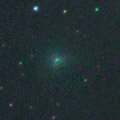
|
First return of a new bright periodic comet. It was observed as an asteroid in June. Now it is so bright as 12.3 mag (Aug. 31, Juan Jose Gonzalez). In the Northern Hemisphere, it keeps observable in a good condition after this. However, it will fade out rapidly, and will be fainter than 18 mag in October.
Date(TT) R.A. (2000) Decl. Delta r Elong. m1 Best Time(A, h)
Sept.19 8 12.87 22 41.0 0.484 0.834 55 14.8 4:20 (266, 37)
Sept.26 8 20.26 23 37.7 0.543 0.880 61 15.6 4:26 (269, 42)
|
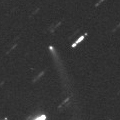
|
Now it is 14.5 mag (July 30, Hidetaka Sato). It keeps observable in good condition at 15 mag until late autumn.
Date(TT) R.A. (2000) Decl. Delta r Elong. m1 Best Time(A, h)
Sept.19 23 58.82 28 48.4 3.030 3.929 149 14.9 0:09 ( 0, 84)
Sept.26 23 49.59 29 34.1 3.029 3.937 151 14.9 23:27 ( 0, 85)
|
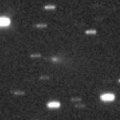
|
Now it is 15.7 mag (Aug. 31, Michael Jager). It will brighten rapidly after this. It will reach to 12 mag and become visible visually in winter. In the Northern Hemisphere, it keeps observable in good condition for a long time after this until 2010 spring when it fades out.
Date(TT) R.A. (2000) Decl. Delta r Elong. m1 Best Time(A, h)
Sept.19 5 18.85 13 1.8 1.796 2.150 96 15.5 4:20 (321, 63)
Sept.26 5 28.82 12 40.4 1.706 2.130 100 14.9 4:26 (334, 66)
|
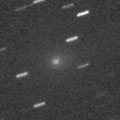
|
Appearing in the morning sky. It is still bright as 13.5 mag (Aug. 29, Hidetaka Sato). It will be getting higher gradually while fading slowly after this.
Date(TT) R.A. (2000) Decl. Delta r Elong. m1 Best Time(A, h)
Sept.19 8 38.08 20 58.0 2.262 1.783 49 15.0 4:20 (265, 31)
Sept.26 8 52.61 19 42.8 2.255 1.833 52 15.2 4:26 (269, 34)
|
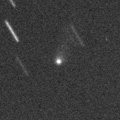
|
Now it is 14.4 mag and visible visually (Sept. 14, Alan Hale). It keeps 15 mag until winter. It keeps observable in a good condition in the Southern Hemisphere. But in the Northern Hemisphere, it will be getting lower gradually, and it is only observable until late autumn.
Date(TT) R.A. (2000) Decl. Delta r Elong. m1 Best Time(A, h)
Sept.19 23 47.36 -18 44.0 1.819 2.794 162 15.3 23:52 ( 0, 36)
Sept.26 23 36.49 -23 3.5 1.828 2.766 154 15.2 23:14 ( 0, 32)
|
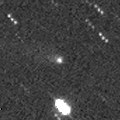
|
Now it is 15.3 mag (Aug. 22, Hidetaka Sato). It keeps 15 mag until 2010, and will be observable for a long time in good condition.
Date(TT) R.A. (2000) Decl. Delta r Elong. m1 Best Time(A, h)
Sept.19 15 33.89 36 35.8 3.091 2.785 63 15.4 19:26 (109, 45)
Sept.26 15 31.73 34 19.1 3.166 2.784 58 15.4 19:15 (108, 40)
|
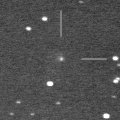
|
Now it is 16.2 mag (Aug. 13, Ken-ichi Kadota), brightening as expected. It will reach up to 12 mag in 2012, and will be observable visually at 12-13 mag for a long time from 2011 to 2013. In 2009, it is observable in good condition at 16 mag from summer to autumn. In the Northern Hemisphere, the comet will be low around its brightest seasons.
Date(TT) R.A. (2000) Decl. Delta r Elong. m1 Best Time(A, h)
Sept.19 22 4.55 2 58.8 7.572 8.488 154 15.7 22:10 ( 0, 58)
Sept.26 22 0.27 2 30.7 7.590 8.452 147 15.7 21:38 ( 0, 58)
|
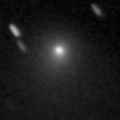
|
It reached to 10.9 mag in 2008 spring (May 11, Marco Goiato). It is fading slowly, but still bright as 15.0 mag (Aug. 20, Hidetaka Sato). Although it becomes low in winter temporarily, it keeps observable for a long time until 2010 spring when it becomes fainter than 18 mag.
Date(TT) R.A. (2000) Decl. Delta r Elong. m1 Best Time(A, h)
Sept.19 16 24.13 29 28.4 5.305 5.078 71 16.1 19:26 ( 94, 53)
Sept.26 16 29.10 28 48.4 5.410 5.129 68 16.2 19:15 ( 94, 50)
|
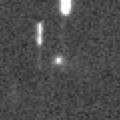
|
Now it is brightest, and it will be fading after October. It keeps observable until January when it becomes fainter than 18 mag. It locates somewhat low in the Northern Hemisphere.
Date(TT) R.A. (2000) Decl. Delta r Elong. m1 Best Time(A, h)
Sept.19 1 28.11 -23 12.4 2.026 2.921 147 16.7 1:37 ( 0, 32)
Sept.26 1 26.20 -25 15.9 2.025 2.923 147 16.7 1:08 ( 0, 30)
|
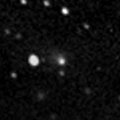
|
It brightened up to 15-16 mag in 2008 summer. Now it is 17.8 mag (Aug. 26, Katsumi Yoshimoto). It keeps observable at 17 mag in good condition for a long time until winter.
Date(TT) R.A. (2000) Decl. Delta r Elong. m1 Best Time(A, h)
Sept.19 3 56.16 32 35.8 2.568 3.086 111 16.9 4:05 ( 0, 88)
Sept.26 3 56.88 33 17.4 2.500 3.102 118 16.9 3:38 ( 0, 88)
|
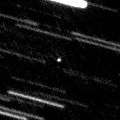
|
It passed the perihelion in June, but it was not observable, too close to the sun. Although it was predicted to be 13.5 mag, the STEREO spacecraft revealed that it brightened up to 10-11 mag, much brighter than expected. Now it is 16.4 mag (Aug. 23, C00). It keeps observable at 16-17 mag until late autumn.
Date(TT) R.A. (2000) Decl. Delta r Elong. m1 Best Time(A, h)
Sept.19 3 53.95 50 22.1 1.075 1.662 106 17.0 4:03 (180, 75)
Sept.26 3 32.29 51 4.2 1.051 1.728 114 16.9 3:15 (180, 74)
|
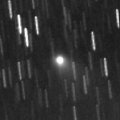
|
It reached up to 12.6 mag and became visible visually in June and July (June 25, Katsumi Yoshimoto). However, it is fading rapidly after August. It has already faded down to 16.8 mag (Aug. 16, Ken-ichi Kadota). It will be fainter than 18 mag in October.
Date(TT) R.A. (2000) Decl. Delta r Elong. m1 Best Time(A, h)
Sept.19 19 29.29 1 41.6 1.195 1.867 115 17.1 19:36 ( 0, 57)
Sept.26 19 39.20 1 14.6 1.300 1.918 112 17.4 19:18 ( 0, 56)
|
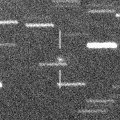
|
Now it is 17.7 mag (Sept. 5, Hidetaka Sato). It will reach up to 15.5 mag. It keeps observable in good condition all through the time until next spring when it becomes fainter than 18 mag.
Date(TT) R.A. (2000) Decl. Delta r Elong. m1 Best Time(A, h)
Sept.19 5 38.85 8 5.8 1.074 1.489 91 17.4 4:20 (318, 57)
Sept.26 6 1.31 7 45.1 1.012 1.455 92 17.2 4:26 (323, 58)
|
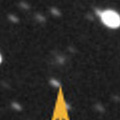
|
The condition of this apparition is bad. It will reach up to 11-12 mag from spring to autumn in 2010, but it is not observable. It will be getting brighter gradually in the evening sky, but it will be too low to observe in January at 15 mag.
Date(TT) R.A. (2000) Decl. Delta r Elong. m1 Best Time(A, h)
Sept.19 20 21.84 1 41.3 2.248 2.984 128 17.3 20:28 ( 0, 57)
Sept.26 20 19.63 1 2.2 2.281 2.941 122 17.3 19:58 ( 0, 56)
|

|
Peculiar asteroid moving along a cometary orbit. Now it is 17.7 mag (Sept. 12, Hidetaka Sato). It reached up to 17 mag in September and October.
Date(TT) R.A. (2000) Decl. Delta r Elong. m1 Best Time(A, h)
Sept.19 1 48.44 0 48.5 1.149 2.076 149 17.6 1:59 ( 0, 56)
Sept.26 1 18.29 -7 0.1 1.097 2.072 161 17.3 1:01 ( 0, 48)
|
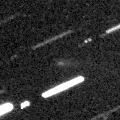
|
Comet Pigott, which has been lost over 200 years since 1783, is identified with a comet discovered in 2003 by LINEAR. Now it is 17.6 mag (Sept. 11, Catalina Sky Survey). Getting higher, but it will be fainter than 18 mag in October.
Date(TT) R.A. (2000) Decl. Delta r Elong. m1 Best Time(A, h)
Sept.19 8 3.87 45 4.3 2.349 2.132 65 17.3 4:20 (239, 45)
Sept.26 8 22.31 46 28.4 2.314 2.166 68 17.4 4:26 (237, 48)
|
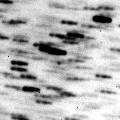
|
Now it is 16.7 mag (Aug. 14, Katsumi Yoshimoto). The condition is good in this apparition. It will approach to the earth down to 0.38 A.U., and will be observable in good condition at 16.5 mag in November. It keeps observable until that time after this. But it locates somewhat low in the Northern Hemisphere.
Date(TT) R.A. (2000) Decl. Delta r Elong. m1 Best Time(A, h)
Sept.19 17 2.72 -18 53.8 0.614 1.087 80 17.4 19:26 ( 36, 27)
Sept.26 17 21.92 -18 50.4 0.587 1.052 78 17.4 19:15 ( 36, 28)
|

|
Now it is 18.6 mag (Aug. 25, W. Hasubick). It will brighten rapidly after this, and will be observable at 15 mag in good condition in winter and spring. It may be visible visually.
Date(TT) R.A. (2000) Decl. Delta r Elong. m1 Best Time(A, h)
Sept.19 5 7.11 14 15.6 2.226 2.580 98 17.6 4:20 (326, 66)
Sept.26 5 13.69 14 10.0 2.108 2.545 104 17.4 4:26 (341, 68)
|
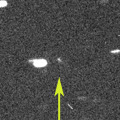
|
It brightened up to 11 mag in outburst in 2003. Now it is 17.4 mag (Sept. 9, Ken-ichi Kadota). It will be observable in good condition in winter. Maybe it brightens up to 14 mag.
Date(TT) R.A. (2000) Decl. Delta r Elong. m1 Best Time(A, h)
Sept.19 0 3.14 13 26.4 1.133 2.118 164 17.8 0:13 ( 0, 68)
Sept.26 23 55.85 13 17.1 1.079 2.069 167 17.5 23:33 ( 0, 68)
|

|
Now it is 17.3 mag (Aug. 23, Ken-ichi Kadota). It keeps observable at 17-18 mag for a long time until 2011.
Date(TT) R.A. (2000) Decl. Delta r Elong. m1 Best Time(A, h)
Sept.19 4 30.58 72 8.6 4.966 5.137 94 17.6 4:20 (182, 53)
Sept.26 4 24.55 73 58.0 4.880 5.120 98 17.5 4:07 (180, 51)
|
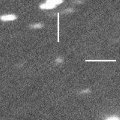
|
It keeps observable at 17 mag for a long time from 2010 to 2012. Now it is 18.5 mag (Aug. 25, W. Hasubick), a bit fainter than this ephemeris.
Date(TT) R.A. (2000) Decl. Delta r Elong. m1 Best Time(A, h)
Sept.19 3 36.65 20 40.0 8.325 8.860 119 17.6 3:46 ( 0, 76)
Sept.26 3 33.14 20 36.1 8.203 8.842 126 17.5 3:15 ( 0, 76)
|
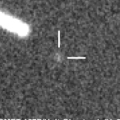
|
It became much brighter than expected. It was originally predicted to be 19 mag, but now it is 17.2 mag (Sept. 13, Yasukazu Ikari). It will be observable in good condition at 17-18 mag until November.
Date(TT) R.A. (2000) Decl. Delta r Elong. m1 Best Time(A, h)
Sept.19 1 14.59 5 35.7 1.249 2.207 156 17.7 1:24 ( 0, 61)
Sept.26 1 9.07 6 10.0 1.220 2.203 164 17.6 0:51 ( 0, 61)
|
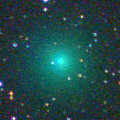
|
It was bright as 8-9 mag in April and May. Although it had been unobservable for a while, now it is appearing in the morning sky. It should be bright as 12 mag still now, however, it has faded down to 16.7 mag actually and become much fainter than expected (Sept. 9, Ken-ichi Kadota). In the Northern Hemisphere, it keeps low after this. In the Southern Hemisphere, it keeps observable in good condition for a long time.
Date(TT) R.A. (2000) Decl. Delta r Elong. m1 Best Time(A, h)
Sept.19 8 4.55 -8 15.1 2.704 2.298 55 17.6 4:20 (296, 20)
Sept.26 8 7.67 -11 23.9 2.688 2.373 61 18.0 4:26 (304, 23)
|

|
Now it is 17.7 mag (Aug. 31, D. Cardenosa and R. Lozano). This comet tends to brighten after the perihelion passage. It will reach up to 16-17 mag in 2010 and 2011.
Date(TT) R.A. (2000) Decl. Delta r Elong. m1 Best Time(A, h)
Sept.19 4 53.11 25 14.0 2.926 3.273 101 17.8 4:20 (315, 77)
Sept.26 4 56.87 25 22.1 2.825 3.264 107 17.7 4:26 (344, 80)
|
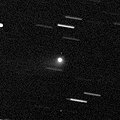
|
It reached up to 14 mag in 2008 autumn. It is still bright as 16.0 mag (July 30, H. Sato). It keeps observable around 17 mag in a good condition for a while.
Date(TT) R.A. (2000) Decl. Delta r Elong. m1 Best Time(A, h)
Sept.19 21 53.64 14 42.3 4.091 4.970 147 17.7 21:59 ( 0, 70)
Sept.26 21 45.25 13 35.4 4.187 5.014 141 17.8 21:23 ( 0, 69)
|

|
Peculiar asteroid moving along a cometary orbit. Now it is 18.1 mag (Sept. 12, Hidetaka Sato). It reached up to 18 mag in September and October.
Date(TT) R.A. (2000) Decl. Delta r Elong. m1 Best Time(A, h)
Sept.19 1 14.21 2 4.6 2.667 3.616 157 18.1 1:24 ( 0, 57)
Sept.26 0 58.52 0 38.9 2.620 3.607 168 17.9 0:41 ( 0, 56)
|
|
![]()
 116P/Wild 4
116P/Wild 4 81P/Wild 2
81P/Wild 2 C/2009 G1 ( STEREO )
C/2009 G1 ( STEREO ) 29P/Schwassmann-Wachmann 1
29P/Schwassmann-Wachmann 1 C/2007 N3 ( Lulin )
C/2007 N3 ( Lulin ) 65P/Gunn
65P/Gunn C/2007 G1 ( LINEAR )
C/2007 G1 ( LINEAR ) C/2006 OF2 ( Broughton )
C/2006 OF2 ( Broughton ) (3552) Don Quixote
(3552) Don Quixote 222P/2009 MB9 ( LINEAR )
222P/2009 MB9 ( LINEAR ) C/2008 P1 ( Garradd )
C/2008 P1 ( Garradd ) 118P/Shoemaker-Levy 4
118P/Shoemaker-Levy 4 64P/Swift-Gehrels
64P/Swift-Gehrels C/2009 O4 ( Hill )
C/2009 O4 ( Hill ) C/2008 N1 ( Holmes )
C/2008 N1 ( Holmes ) C/2006 S3 ( LONEOS )
C/2006 S3 ( LONEOS ) C/2006 Q1 ( McNaught )
C/2006 Q1 ( McNaught ) P/2009 Q5 ( McNaught )
P/2009 Q5 ( McNaught ) 47P/Ashbrook-Jackson
47P/Ashbrook-Jackson (3200) Phaethon
(3200) Phaethon P/2009 L2 ( Yang-Gao )
P/2009 L2 ( Yang-Gao ) P/2009 Q4 ( Boattini )
P/2009 Q4 ( Boattini ) 43P/Wolf-Harrington
43P/Wolf-Harrington 2009 QY6
2009 QY6 226P/2009 R2 ( Pigott-LINEAR-Kowalski )
226P/2009 R2 ( Pigott-LINEAR-Kowalski ) 107P/(4015) Wilson-Harrington
107P/(4015) Wilson-Harrington 30P/Reinmuth 1
30P/Reinmuth 1 157P/Tritton
157P/Tritton C/2007 VO53 ( Spacewatch )
C/2007 VO53 ( Spacewatch ) C/2008 S3 ( Boattini )
C/2008 S3 ( Boattini ) 127P/Holt-Olmstead
127P/Holt-Olmstead C/2009 F6 ( Yi-SWAN )
C/2009 F6 ( Yi-SWAN ) 203P/2008 R4 ( Korlevic )
203P/2008 R4 ( Korlevic ) C/2007 U1 ( LINEAR )
C/2007 U1 ( LINEAR ) 2008 SO218
2008 SO218![]()



































